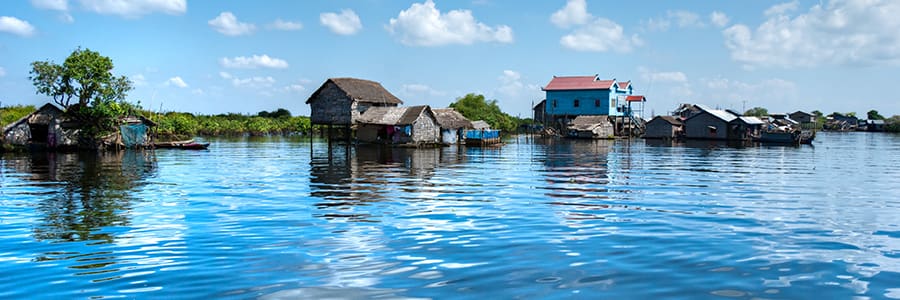
About The Mekong River
The Vietnamese call the river Song Cuu Long, the Nine Dragons River, for the nine branches of the Mekong Delta.
Rising in southeastern China and flowing through or past Tibet, Myanmar, Laos, Thailand, Cambodia, and Vietnam, the Mekong, at approximately 2,700 miles in length, is the longest river in Southeast Asia, the 7th longest in Asia, and the 12th longest in the world.
In spite of its size and importance to six different countries, the river remains one of Asia’s least-developed waterways; in fact, the Mekong’s biodiversity is second only to that of the Amazon, with thousands of species of plants and a wealth of mammals, birds, reptiles, and fish. Extraordinary natural beauty, like the UNESCO-listed Ha Long Bay, is just one facet of this magical country — you’ll also discover golden temples, floating markets, ancient villages, bustling cities, tuk tuk and elephant rides, puppet shows, and gracious, friendly people.
All the major river cruise lines offer Mekong trips in Vietnam and Cambodia, including AmaWaterways, Avalon Waterways, Pandaw, Uniworld, Viking Cruises, and CroisiEurope. Although itineraries are offered for most of the year, the best time to go is during the winter months, November through February.
Mekong River Stats
Length: 2,703 miles
Depth: Average 7 feet
Source: The Himalayas of Tibet
Mouth: The Mekong Delta into the South China Sea near Ho Chi Minh City, Vietnam
Locks: 0
Countries: China | Myanmar | Thailand | Laos | Cambodia | Vietnam
Learn More About the Mekong River
The Lower Mekong River, often referred to simply as the Mekong, is a vital and iconic waterway in Southeast Asia. Spanning approximately 4,350 kilometers (2,703 miles), the Mekong River flows through six countries: China, Myanmar (Burma), Laos, Thailand, Cambodia, and Vietnam, before it empties into the South China Sea. This mighty river has played an integral role in the history, culture, and livelihoods of the people living along its banks. In this essay, we will explore the significance of the Lower Mekong River, its ecological importance, economic contributions, and the various challenges it faces in the modern era.
Geography and Ecology
The Lower Mekong River basin encompasses a vast and diverse landscape. It flows through rugged mountains, lush tropical forests, and fertile plains. The river is divided into several segments, each with its unique characteristics. The upper reaches originate in the Tibetan Plateau, and it travels through steep canyons and deep gorges, characterized by fast-flowing waters. As it descends into Southeast Asia, it slows down, meandering through lush wetlands and forming the famous Mekong Delta in Vietnam. This delta is one of the most productive agricultural regions in the world, often referred to as the “Rice Bowl” of Southeast Asia.
The ecological diversity along the Mekong River is unparalleled. The river basin is home to numerous rare and endangered species, including the Irrawaddy dolphin, Mekong giant catfish, and Siamese crocodile. The river’s annual flood pulse plays a crucial role in replenishing nutrients in the floodplain, supporting both terrestrial and aquatic ecosystems. The wetlands along the Mekong River serve as breeding grounds for various fish species, which are the primary source of protein for millions of people in the region.
Economic Significance
The Mekong River is not only a lifeline for the environment but also for the economies of the countries it flows through. The river supports diverse economic activities, including agriculture, fisheries, transportation, and hydropower generation.
Agriculture: The fertile soils of the Mekong Delta are ideal for rice cultivation. It is estimated that the delta produces over half of Vietnam’s rice crop, making it a significant contributor to the nation’s food security. Additionally, other crops like sugarcane, coconut, and fruit orchards thrive in this region.
Fisheries: The Mekong River is one of the most productive freshwater fisheries in the world. It provides a critical source of protein for millions of people in Southeast Asia. The annual fish catch from the Mekong is estimated to be worth billions of dollars.
Transportation: The Mekong River has historically served as a vital transportation route, facilitating the movement of people and goods between the countries it traverses. Even today, it remains an important transport artery, supporting trade and commerce.
Hydropower: The river’s swift currents and elevation changes make it a prime location for hydropower generation. Several dams and power plants have been built along its course to harness this energy source, contributing to the region’s energy needs.
Challenges and Concerns
While the Mekong River has been a source of prosperity for the region, it faces several pressing challenges in the modern era:
Hydropower Dams: The construction of hydropower dams, particularly in China and Laos, has raised concerns about their environmental impact. These dams alter the river’s natural flow, affecting fisheries, sediment deposition, and the livelihoods of downstream communities.
Climate Change: Climate change has led to erratic weather patterns, including prolonged droughts and more severe floods. These changes can disrupt agriculture and impact the river’s ecosystem.
Biodiversity Loss: Habitat destruction, overfishing, and pollution threaten the biodiversity of the Mekong River. Several iconic species are at risk of extinction.
Water Pollution: Rapid urbanization and industrialization have led to increased water pollution along the Mekong, endangering both aquatic life and the health of communities relying on the river for drinking water.
Transboundary Issues: The management of the Mekong River involves cooperation between multiple countries, and disputes over water usage and resource allocation can strain international relations.
